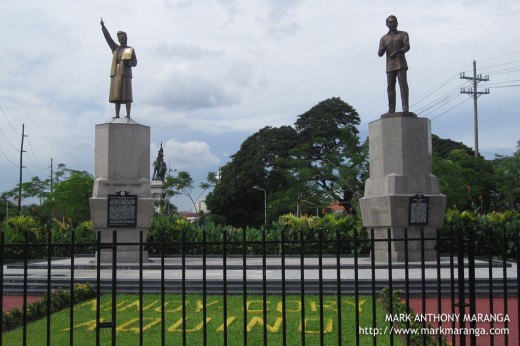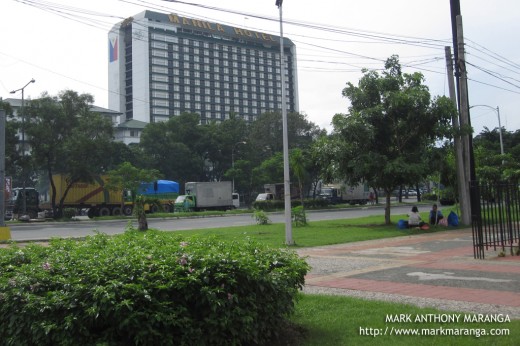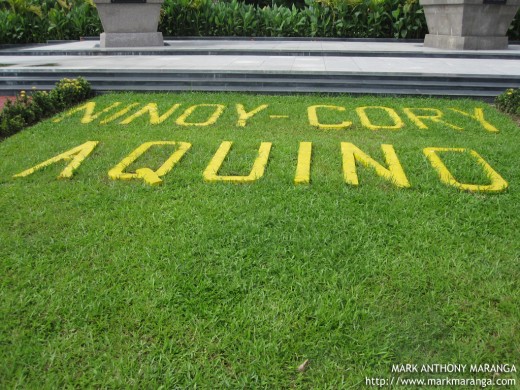Benigno Simeon “Ninoy” Aquino, Jr. and Corazon “Cory” Aquino are the parents of incumbent President Benigno “Noynoy” Aquino III of the Philippines. Because of their exemplary service to the Filipino people, they were recognized as heroes of the country – this is why the Ninoy-Cory Aquino Monument is erected to remember them. They are couples who worked hard for the democracy and peace of the Philippines, thus giving them a monument (together) in Manila, the nation’s capital.
Ninoy Aquino
Benigno Simeon “Ninoy” Aquino, Jr. was born on November 27, 1932 and died on August 21, 1983. Ninoy was a Governor of Tarlac, then Philippine Senator and an opposition leader against President Ferdinand Marcos who held office from 1965 to 1986. He was assassinated at the Manila International Airport (later renamed in his honor) upon returning home from exile in the United States. His death catapulted his widow, Corazon Aquino, to the limelight and subsequently to the presidency, replacing the 20-year Marcos presidency. In 2004, the anniversary of his death was proclaimed as a national holiday now known as Ninoy Aquino Day.
Another memorial of Ninoy, the Ninoy Aquino Monument, can be seen in Makati. It is a bronze monument made by sculptor Peter de Guzman which commemorates the slain of the Filipino hero.
Cory Aquino
Maria Corazon Sumulong Cojuangco-Aquino was born on January 25, 1933 and died on August 1, 2009. Cory was the 11th President of the Philippines and the first woman to hold that office. Aquino was also the first popularly and democratically-elected female president and head of state in Asia. Cory is best remembered for leading the 1986 People Power Revolution, which toppled Ferdinand Marcos and restored democracy in the Philippines. “Tita (Auntie) Cory”, as she was affectionately known, is revered by many Filipinos as an icon of democracy and was hailed by TIME Magazine in 1986 as its ‘Woman of the Year.’
Cory was self-proclaimed “plain housewife”. After her husband’s assassination, the widowed Aquino became the reluctant leader of the opposition against the authoritarian rule of the Marcos regime. She united the fragmented opposition and strengthened its moral crusade against the abuses and excesses of President Marcos’ martial rule. In late 1985, when President Marcos called for a snap election, Cory Aquino challenged his regime. Aquino thrust herself into the political arena after one million signatures urging her to run for president were presented to her.
Despite having no political experience, Aquino proved to be an effective leader, inspiring orator and skilled campaigner. She ran for president with former senator Salvador Laurel as her vice-presidential running mate. After the elections were held on February 7, 1986, the Marcos-controlled Batasang Pambansa proclaimed him the winner in the elections, Aquino called for massive civil disobedience protests against him, declaring herself as having been cheated and as the real winner in the elections. Filipinos enthusiastically heeded her call and rallied behind her. These series of events eventually led to the ousting of Marcos and the installation of Aquino as President of the Philippines on February 25, 1986 through the People Power Revolution.
As President, Aquino oversaw the restoration of democracy in the Philippines and the promulgation of a new constitution, which limited the powers of the presidency and established a bicameral legislature. Her administration gave strong emphasis and concern for civil liberties and human rights, peace talks and dialogues with communist insurgents and Muslim secessionists. Aquino’s economic policies, meanwhile, centered on bringing back economic health and confidence and focused on creating a market-oriented and socially-responsible economy. Despite these achievements, Aquino’s presidency was not smooth-sailing as she had to face series of coup attempts against her administration and destructive natural calamities and disasters until the end of her term in 1992.
Succeeded by Fidel V. Ramos as President in 1992, Aquino returned to private life although she remained active in the public eye, constantly voicing her views and opinions on the pressing political issues in the country. In 2008, Aquino was diagnosed with colon cancer and after a one-year battle with the disease, died on August 1, 2009.
The Monument
The Ninoy-Cory Aquino Monument stands as a commemoration of the good deeds the couple has done to the country. Their achievement is emblematic. They both loved their countrymen and believed that democracy is for the greater good.
The Ninoy-Cory Aquino Monument is located in the corner of Bonifacio Drive and C1/Padre Burgos Street. It is meters away from the Legazpi-Urdaneta Monument. About 250 meters going south is Kilometer Zero nearby Quirino Grandstand. 200 meters going west is Manila Hotel, the oldest premiere hotel in the Philippines. 2 kilometers going north is Pasig River.
For those who want to visit Manila, you may want to drop by the Ninoy-Cory Aquino Monument and take your hats off for a moment. These are the two persons who successfully fought for our country’s democracy. If not for them, we may still be under Martial Law.
This page is last updated on



 Mark Anthony Maranga is an Educator-Parent to his 3 Homeschooling Kids. He sells
Mark Anthony Maranga is an Educator-Parent to his 3 Homeschooling Kids. He sells 











Fell out of bed fleeing down. This has brightened my day!
the couple deserve it!! i hope president Noy will give his best for the country same as his parents did.